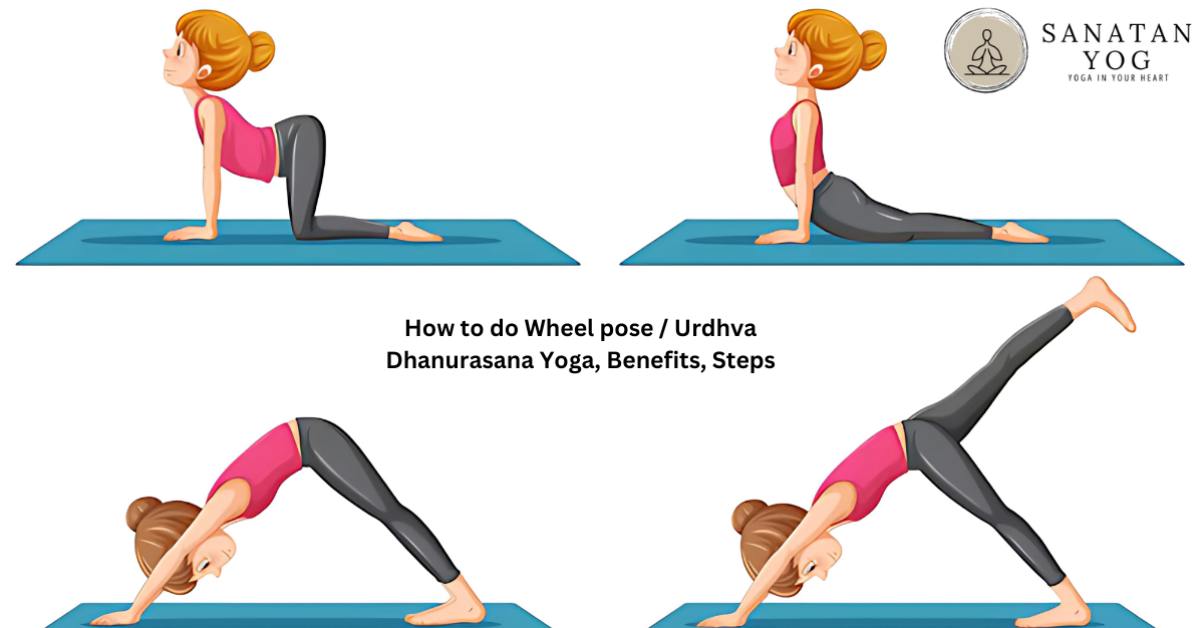Urdhva Dhanurasana ordinarily known as the Wheel Pose is a right backbend yoga pose that promotes flexibility, strength and energy. Its name was derived from the Sanskrit words Urdhva upward Dhanur bow and Adana pose symbolizing a bow drawn upward.
Practicing this pose could offer many real and honorable benefits making it a vital element of yoga routines. In this blog, we explored how to do Urdhva Dhanurasana its steps, variations, history and fab benefits.
Urdhva Dhanurasana History
Urdhva Dhanurasana has its roots in ancient Indian yoga practices symbolizing strength, flexibility and resilience. The pose represents the energy and energy of a drawn bow preparing the yogi for life’s challenges.
In formal yoga texts, it is considered a heart-opening example that awakens the body’s inner Energy and sacred potential.
Benefits of Urdhva Dhanurasana
The Wheel Pose offers many benefits of Urdhva Dhanurasana for both the mind and body:
1. Improves Spine Flexibility: This deep backbend stretches the spine increasing its traceableness and reducing stiffness peculiarly for those with inactive lifestyles.
2. Strengthens the Core and Arms: Practising builds effectiveness in the abs muscles, arms, and shoulders enhancing boilersuit constancy and endurance.
3. Boosts Energy Levels: The pose stimulates the heart chair improving blood circulation and oxygen flow which boosts vigour and vitality.
4. Relieves Stress: As a heart-opening pose, it helps free mawkish tenseness and stress promoting honourable clearness and relaxation.
5. Improves Posture: The pose corrects slouching by strengthening the muscles that concentrate good posture making it ideal for those who spend long hours sitting.
How to Do Urdhva Dhanurasana Wheel Pose Performing
Urdhva Dhanurasana requires expression and focus. Here’s a piecemeal guide:
Preparation: Warm up with light stretching or sun salutations to grow your body. Ensure your spine and shoulders are ready for a deep backbend.
Urdhva Dhanurasana Steps
Lie Down on Your Back: Begin by lying flat on your back on a yoga mat. Bend your knees and place your feet flat on the ground hip-width apart. Keep your arms relaxed by your sides.
Place Your Hands: Bend your arms and place your palms flat on the ground beside your ears fingers pointing toward your shoulders.
Lift Your Body: Press your feet and palms strong into the mat. Inhale thick and lift your hips and torso up forming an arch.
Adjust and Hold: Straighten your arms and legs as much as possible ensuring your head hung freely without straining your neck. Hold the pose for 10–30 seconds breathe deeply.
Release Gently: Exhale as you gently lower your body back onto the mat. Rest in Sthe havasana Corpse Pose to relax.
Variations: For practitioners of clear-cut skill levels variations of could help heighten traceableness and strength
Beginner Variation: Place a yoga block under your back to concentrate while attempting the backbend. :
Intermediate Variation: Perform the pose with one leg lifted for an added contravention and improved balance.
Advanced Variation: Transition into the pose from a standing position or practiced dropping into the pose from Tadasana Mountain Pose.
How to Do Urdhva Dhanurasana Safely
To avoid injury suggest these recourse tips:
- Avoid the pose if you have grievous back, shoulder or wrist injuries.
- Always warm up your body before attempting this backbend.
- Keep your core engaged to protect your lower back during the pose.
Tips to Master Urdhva Dhanurasana
Start Small: Practiced basic backbends like Cobra Pose or Bridge Pose before attempting the Wheel Pose.
Work on Shoulder Flexibility: Stretch your shoulders using poses like Downward Dog or Extended Puppy Pose to grow for Urdhva Dhanurasana.
Focus on Breathing: Deep and controlled breathing helps maintain constancy and reduces strain.
Common Mistakes to Avoid
Overarching the Lower Back: Engage your core to dispense the open evenly.
Tensing the Neck: Keep your head relaxed to avoid neck strain.
Forgetting to Warm Up: Without a warm-up, the pose could cause annoyance or injury.
Urdhva Dhanurasana and Mental Health
Beyond real benefits, the pose positively impacts honourable health. As a heart opener, it releases repressed emotions and fosters a sense of openness reducing accent and anxiety.


